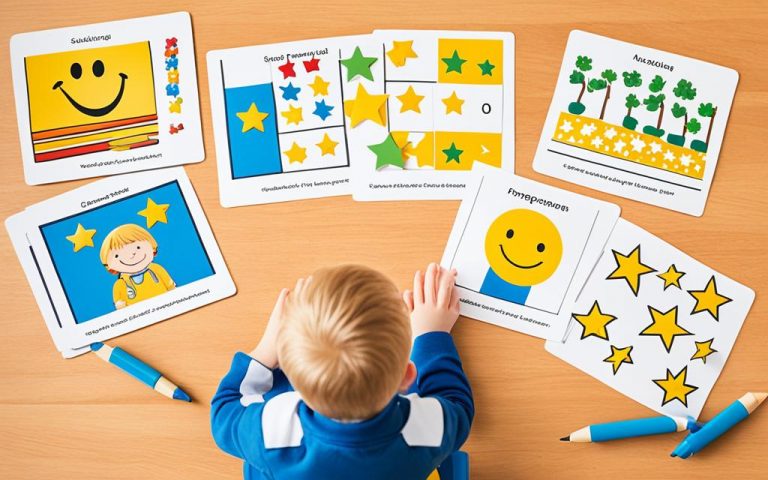Autism Therapy Techniques for Parents: A Helpful Guide
Embarking on the parenting journey with an autistic child is both rewarding and challenging. It’s critical to arm yourself with autism therapy techniques for parents. In this guide, you’ll find strategies designed to help your child take their first steps towards growth and development. These autism parenting strategies are essential for improving your child’s quality of life, creating a learning-friendly space, and encouraging positive changes.
Key Takeaways
- Understanding comprehensive autism therapy techniques for parents.
- Applying practical and effective autism parenting strategies at home.
- Enhancing the quality of life for children on the spectrum.
- Creating a supportive learning environment for children with autism.
- Recognizing the importance of consistency in implementing therapy techniques.
- Leveraging personalized strategies to meet individual needs.
Understanding Autism and Its Impacts on Families
Autism Spectrum Disorder (ASD) poses unique difficulties that can greatly influence family life and growth. Autism early intervention programs play a vital role in aiding those diagnosed and their families. This part explores the meaning of ASD and the emotional paths that families walk.
Defining Autism Spectrum Disorder
The Centers for Disease Control and Prevention (CDC) defines Autism Spectrum Disorder as a brain-based developmental condition. People with ASD show differences in behavior, communication, social interaction, and learning. It’s crucially important to realize the wide spectrum of abilities within autism for constructive autism early intervention programs to take effect.
The Emotional Journey for Parents and Siblings
Learning of a family member’s autism diagnosis unleashes a myriad of emotions. These can range from doubt and bewilderment to understanding and empowerment. Such news initiates a path to a new life, eased by autism parent support resources. Let’s examine the steps families might take:
- Shock and denial following the initial diagnosis.
- Anxiety about the future and how to manage it.
- Gradual learning and adaptation to new routines and therapies.
- Engagement with communities and resources that offer support and guidance.
- Empowerment and advocacy to help reshape public perceptions about autism.
Disseminating autism parent support resources is pivotal for families facing this diagnosis and its adaptations. These resources serve as a connection to understanding and expert advice, building a community. This network strengthens families, empowering them to advocate for their loved ones.
Equipping families with knowledge and support shifts their role from coping to actively managing and engaging with society. This change supports both the individual with ASD and the entire family, preparing them for the daily hurdles they might encounter.
Setting the Stage: Creating an Autism-Friendly Home Environment
It’s crucial to make a home welcoming for children with autism. This approach helps them with both autism sensory integration therapy and autism social skills training. You can transform your home into a space that meets your child’s developmental and daily requirements.
- Designate Calming Spaces: Set up spots at home that are specifically for peace and comfort. These nooks should have gentle lighting, low noise, and comfortable seating for relaxation.
- Organize Sensory Tools: Keep a special place for sensory toys and supports. This makes it easier to access items that help with staying calm and focused, which is essential for autism sensory integration therapy.
- Routine Charts: Use charts that visually lay out a daily routine. This structure aids in lessening anxiety and supports autism social skills training.
Improving your home for someone with autism goes beyond design changes. It’s about incorporating habits that encourage social engagement and sensory well-being. Here, we’ll share some actionable tips:
| Area of Focus | Strategies | Benefits |
|---|---|---|
| Sensory Integration | Use of textured materials, varied lighting | Enhances sensory processing |
| Social Skills | Having play areas for interaction | Enhances communication skills |
| Safety | Securing cabinets, creating safe spots | Boosts physical safety and peace of mind |
By including autism sensory integration therapy and autism social skills training in your home, you’re building a supportive haven. Every tiny change you make can improve how your child engages with their world and the people within it.
Autism Behavioral Interventions: What Parents Need to Know
Parents play a crucial role in their child’s journey with autism behavioral interventions and autism early intervention programs. Understanding their worth is key to helping a child with autism grow. These programs are tailor-made, aiming to cultivate essential behavioral changes and spark developmental enhancements.
The Principles of Behavior Modification
Central to many successful autism interventions is behavior modification. It includes a range of methods to boost positive behaviors and diminish negative ones. This process relies on consistent observation and the application of positive rewards. Studies indicate this can usher in outstanding improvements in behavior.
Engaging in autism early intervention programs equips parents with vital tools for transformative change. Sessions often focus on teaching parents how to wield these behavior-shaping methods at home. Something as simple as rewarding good behavior can have profound effects.
| Technique | Description | Expected Outcome |
|---|---|---|
| Positive Reinforcement | Reward desired behaviors to encourage repetition. | Increases positive behavior occurrences. |
| Task Analysis | Breaking tasks into simpler, manageable steps. | Improves learning and task completion. |
| Role-Playing | Use simulations to practice social interactions. | Enhances social skills and situational responses. |
Initiating these strategies at an early stage can greatly enhance a child’s developmental path. The primacy of early intervention cannot be overstated for securing enduring positive outcomes. When woven into daily life, these autism behavioral interventions assist in managing behaviors. They also aid in facing daily challenges, creating an environment conducive to continual growth.
Implementing Reward Systems and Consistency
Autism applied behavior analysis highlights the powerful effect of reward systems on children with autism. It’s essential to consistently use these systems along with autism communication methods. Doing so integrates them into your child’s routine, fostering lasting positive changes in behavior.
The intricate design of reward systems is key. They must be personalized, rewarding attainable behaviors that benefit the child’s long-term growth. This tailored and consistent approach establishes a supportive setting. It aids in your child’s advancement, particularly in communication and behavior.
“Success in behavioral therapy is about consistency and tailored rewards. Recognize small victories and ensure that the rewards align with the child’s needs and preferences to maintain motivation.”
Setting Up Effective Reward Systems
- Define clear and measurable goals that are appropriate to your child’s developmental level.
- Choose rewards that are meaningful and motivating for your child.
- Be consistent with rewards; this helps in establishing predictable outcomes for actions.
- Use visual aids and other autism communication methods to help your child understand the link between behaviors and rewards.
Consistency in implementing these strategies is as crucial as the strategies themselves. A lack of it could confuse the child about the consequences of their actions, slowing behavioral development.
| Behavior | Reward | Outcome Observed |
|---|---|---|
| Completion of a communication task | Extra playtime | Increased eagerness to engage in tasks |
| Cooperation during routine changes | Choice of activity | Improved adaptability |
| Reduction in tantrums | Small treat or token | Decrease in frequency of tantrums |
Adhering to autism applied behavior analysis and incorporating autism communication methods significantly enhances your intervention effectiveness. These methods not only better behavior but also boost communication. They empower your child to effectively express needs and emotions.
Developing Communication Skills with Autism Communication Methods
Enhancing communication skills in autistic children involves meticulously designed strategies. These approaches aim to narrow the gap in both verbal and nonverbal communication. By utilizing autism communication methods and autism sensory integration therapy, parents can make a profound impact. They help their children better express needs and emotions.
Nonverbal Communication Strategies
For many autistic children, nonverbal communication is a primary mode of interaction. Key techniques such as sign language, understanding facial expressions, and interpreting body language can be pivotal. They provide alternate means of expression. These tools decrease communication barriers, fostering clearer communication and reducing frustration.
Using Visuals to Enhance Understanding
Autism communication methods heavily rely on visual supports. These include picture cards, schedules, and symbols. Such resources aid children in understanding information more effectively and independently. The addition of autism sensory integration therapy enhances these benefits. It helps in making activity transitions smoother. This can lower instances of sensory overload and related behavioral challenges.
Key elements in communication development include:
- Consistency in applying communication methods
- Regular reinforcement through practice
- Personalized adjustments, responding to the child’s needs
| Method | Description | Benefits |
|---|---|---|
| Visual Schedules | Graphic representation of a sequence of activities | Enhances predictability and structure |
| Sign Language | Use of manual communication to convey messages | Reduces reliance on verbal skills |
| Pictorial Communication | Use of pictures to signify objects, actions, or concepts | Builds visual thinking and interpretation skills |
Autism Therapy Techniques for Parents: Practical Application
Incorporating autism behavioral interventions and autism parenting strategies into daily life reshapes family dynamics. Understanding their applied significance is key. We offer a guide to seamlessly apply these strategies in your family routine.
Effective implementation of autism interventions demands more than theoretical knowledge. It necessitates observing how these strategies work in real life. Practical insights from experts, combined with case studies, provide actionable steps that deliver tangible results.
- Start Small: Begin by integrating simple strategies into your routine, and steadily build as your child and family adjust.
- Daily Schedules: Providing consistent routines can significantly benefit children with autism. Customize daily activities to reflect endorsed therapeutic interventions.
- Visual Aids: Employ visual aids to enhance communication and behavior modification strategies. This improves your child’s understanding and cooperation.
Testimonials from fellow parents can also be a wellspring of support and inspiration. A parent shared the following:
“Using tailored autism parenting strategies has transformed our whole family’s interaction with daily challenges. We now deeply understand our child’s needs and how to approach troubles.” – A Parent’s Insight
Introducing autism behavioral interventions early establishes a robust platform for developing coping skills and adapting behaviors. Seeing your child’s positive changes directly validates the effectiveness of these interventions.
By integrating these evidence-based autism parenting strategies into your approach, you not only foster a supportive environment for your child, but also further their developmental progress towards ultimate success.
Nurturing Social Interactions Through Autism Social Skills Training
For children with autism, enhancing social abilities is vital. It aids their integration into community settings. By combining autism social skills training with autism applied behavior analysis, their interactions can greatly improve.
Role-Playing and Social Stories
Role-playing and social stories are powerful teaching tools. They help kids learn social behaviors and how to respond in various situations. These methods provide a platform for children to practice and imagine their success in social settings in a controlled setting.
- Role-playing mimics real-life interactions, showing children how to behave and interact effectively.
- Through social stories, the complexities of social interactions are simplified, making real-life scenarios easier to navigate.

Encouraging Peer Interactions
Peer interaction is central to autism social skills training. It is important to create opportunities for children to engage in small group activities. This allows them to apply the social skills learned in therapy.
- Structured group activities ensure every child takes part, fostering a sense of inclusion and personal achievement.
- Consistent social groups offer the repetition needed for children to internalize new social skills.
| Technique | Description | Benefits |
|---|---|---|
| Role-Playing | Simulating social scenarios where children can practice responses. | Enhances both verbal and non-verbal communication skills. |
| Social Stories | Depicts social situations and the correct behaviors, making it easier to understand social cues and appropriate responses. | Enhances understanding of social cues and proper behavior. |
| Structured Peer Interactions | Play sessions designed to encourage socialization. | It helps in boosting confidence and adaptability in social situations. |
By using autism applied behavior analysis, you can monitor and comprehend your child’s progress. It allows the adaptation of techniques to meet your child’s changing needs. With this approach, you not only ensure learning but also the mastery of crucial social skills for everyday life.
Exploring Autism Sensory Integration Therapy Options
Sensory integration therapy plays a vital role in the treatment of many children with autism. It helps them deal with their specific sensitivities to the world. This method combines sensory integration and behavioral therapies, creating a supportive atmosphere for learning and growth.
Identifying Sensory Sensitivities
The first step in effective therapy is recognizing a child’s unique sensory sensitivities. This allows therapists and parents to adjust their strategies accordingly. Sensitivities can include reactions to light, sound, touch, and specific textures.
Sensory Play Activities
Sensory play fosters comfort, confidence, and skill development by engaging children in safe challenges. These activities help manage and can reduce sensitivities over time.
| Activity | Benefits | Sensory Focus |
|---|---|---|
| Sand Play | Improves fine motor skills, encourages creativity | Touch, Sight |
| Water Tables | Enhances problem-solving skills, promotes relaxation | Touch, Hearing |
| Sound Tubes | Develops auditory processing abilities, enhances listening skills | Hearing |
| Textured Balls | Boosts tactile integration, encourages physical activity | Touch |
Integrating these activities into a child’s routine helps create a supportive environment. This can happen both at home and in professional therapy settings. Such an approach is key to making the environment more enriching for kids with autism.
Seeking Support: Autism Parent Support Resources
Starting this journey with your child shows how vital autism parent support resources and autism early intervention programs are. They offer emotional support and practical guidance. It’s important to know what support is out there, to build your own network.
Both online and real-world support groups are invaluable. Connecting you with parents facing similar challenges, they offer immediate support and understanding. Advocacy groups provide resources to help secure the services your child needs.
Educational materials made for parents of autistic children break down autism’s complexities. They give you strategies to understand and meet your child’s needs.
| Resource Type | Description | Benefits |
|---|---|---|
| Support Groups | Communities of parents and caregivers | Shared experiences, emotional support |
| Advocacy Organizations | Groups focused on policy and support services | Resources for rights and educational needs |
| Educational Materials | Guides and articles | Increased understanding and practical tips |
Getting involved in autism early intervention programs changes the game. It shapes your approach to autism and builds a community around you. These programs tailor learning and care to your child’s special requirements.
Applied Behavior Analysis (ABA) Therapy in Practice
Applied Behavior Analysis (ABA) is rooted in empirical evidence regarding behavior and its environmental influences. When applied, ABA plays a critical role in treating the complexities faced by autistic children. It aids in enhancing their educational, communicative, and social abilities. Thus, autism applied behavior analysis and autism behavioral interventions are essential elements in overcoming autism’s challenges.
Understanding the Basics of ABA
ABA therapy is designed to promote beneficial behaviors while mitigating those that are harmful or act as barriers to learning. It involves systematic observation of behaviors and their causes, followed by analysis. Therapists then create customized intervention plans that use positive reinforcement to boost favorable behaviors.
How to Incorporate ABA Techniques at Home
Utilizing ABA strategies in a home environment involves teamwork between parents and therapists. It requires a deep understanding and application of autism applied behavior analysis. This approach aims to make the home a place where the child is less stressed and more inclined to learn and interact effectively.
For home implementation of autism behavioral interventions, initiating a strict routine is beneficial. Consistency in schedules is known to make children with autism feel secure and grasp what’s expected of them. Applying ABA in play and other daily activities can further support developmental goals.
Here’s a simple guide to get you started with ABA at home:
- Observe and Identify: Begin by closely observing your child to note his or her specific needs, what triggers negative behaviors, and where there are teaching opportunities.
- Set Clear Goals: It’s essential to establish precise behavior change goals that are SMART: specific, measurable, attainable, relevant, and time-bound.
- Choose Reinforcers: Pinpoint what drives your child and use these motivators as positive rewards to encourage the learning of new skills.
- Implement Strategies: Utilize ABA techniques like task analysis, prompting, and fading to help your child develop requisite behaviors and abilities.
- Track Progress: Regularly document your child’s behavior and the effectiveness of the strategies you’re using. This allows you to adjust your approach as necessary.
By consistently employing ABA techniques, parents can witness significant enhancements in their child’s behavior and skill set. This not only advances their development but also betters their quality of life.
The Importance of Early Intervention in Autism
Effective autism management starts with early detection. It is crucial to recognize the signs early on. Engaging with autism intervention programs at this stage is key. These programs tailor to every child’s unique needs. They employ specialized communication techniques necessary for growth.
Spotting Early Signs and Taking Action
Spotting autism’s signs early can be hard but is vital. Look out for delayed speech, avoiding eye contact, or repetitive actions. Such behaviors may signal autism. Once you notice such signs, consulting a healthcare expert should be your next move. They’ll help you navigate the diagnostic process. Taking quick action is critical for the intervention to be effective.
Navigating Autism Early Intervention Programs
After diagnosis, finding the right early intervention program is important. These programs offer various therapies. These interventions aim to enhance communication, social skills, and behavior.
Below is a table highlighting key information on different autism intervention approaches:
| Program Type | Focus Area | Techniques Used |
|---|---|---|
| Behavioral Interventions | Behavioral Skills | Applied Behavior Analysis (ABA), Discrete Trial Training |
| Developmental Models | Cognitive and Social Development | Early Start Denver Model, Relationship Development Intervention |
| Naturalistic Teaching Strategies | Context-Based Learning | Incidental Teaching, Pivotal Response Training |
| Speech Therapy | Communication Skills | Speech Generating Devices, Picture Exchange Communication Systems |
Evaluating the available interventions helps find what fits your child best. Choosing the right program is about more than just imparting skills. It’s about starting a lifelong journey of learning and adaptation.
Building Routines: A Key Strategy in Autism Parenting
Integrating autism parenting strategies can make daily life easier for both you and your child. Structured routines help maintain a peaceful home and improve autism social skills training. This approach offers a sense of security to your child.
Children with autism do well in stable, predictable environments. Such settings can lower anxiety and manage sensory issues. Having a clear routine supports your child’s daily activities and learning. Here are tips for creating such routines:
- Start with basics: Set fixed times for meals, school, therapy, and sleep.
- Visual schedules: Use charts or pictures to outline the day. This aids your child in understanding and preparing for upcoming events.
- Keep the order consistent: For meals or bedtime, a consistent sequence offers predictability.
- Let your child help: Allow them to pick activities’ order in the schedule or choose clothes for the next day.
- Make changes slowly: Gradual changes to the routine are easier for your child to handle.
- Integrate social training: Include autism social skills training in daily activities. Practice greetings and turn-taking often.
By using these tips, you’re not only supporting your child’s current needs but also preparing them for their future. A solid routine enhances their learning and social interaction. It creates a positive environment for growth and success.
Technology as an Aid: Using Digital Tools for Autism
Embracing digital tools in autism therapy can significantly enhance your child’s learning experience. Technology brings unique, engaging methods that support various autism behavioral interventions. It’s instrumental in both managing and improving essential skills for children on the spectrum.
Technology excels at personalizing learning for children with autism. With customizable apps and software, educational activities can be tailored to meet your child’s individual needs. This personal touch makes autism therapy techniques for parents more efficient.
“Using technology, we can create a more engaging and controlled environment that can be adjusted to suit the sensory sensitivities of children with autism.”
Moreover, digital tools offer structured, consistent support, vital for autism behavioral interventions. Devices like tablets provide an interactive medium where kids can work on their social and communication skills. This method allows them to advance at their own pace.
| Tool Type | Uses | Benefits |
|---|---|---|
| Therapeutic Apps | Behavioral tracking and reinforcements | Provides immediate feedback, enhances motivation |
| Educational Games | Developing cognitive and motor skills | Improves learning retention, promotes fun learning |
| Communication Software | Enhancing communication abilities | Supports development of speech and nonverbal skills |
Additionally, online platforms and virtual reality can offer simulated, yet real-like, scenarios for enhancing social skills. This serves as a safe, error-friendly environment for learning, free from immediate real-world pressures.
Integrate these technological aids into your autism therapy techniques for parents. They harmonize with traditional methods, enhancing learning and developmental strategies in autism therapy.
Conclusion
Supporting a child with Autism Spectrum Disorder demands dedication and patience. It also requires access to a variety of resources. These are vital for handling the obstacles that may come your way.
The guide has highlighted several autism therapy strategies. It aims to illuminate a path towards bettering your child’s development. From the essential knowledge of autism to the thorough look at sensory integration therapy, we’ve compiled a wealth of information. This is to help in your critical role as a parent.
The chapters have emphasized the importance of personalized plans. This reiterates that every child’s needs and abilities are unique. It is crucial to create strategies that match their specific journey. We aim for this guide to help you in integrating autism therapy at home.
Remember, you are not alone. Many parental support resources are available to you. They are ready to provide help and support whenever you may require it.
While applying what you have learned, remember that consistency is key to progress. Your steadfast use of the techniques outlined here will create a better learning and growth environment for your child. Feel confident in having a range of autism therapy strategies at your disposal. Know that each day, you are significantly impacting your child’s life.
Continue to seek knowledge and refine your approach. Your hard work and adaptation are crucial for your child’s future success. These steps are the cornerstone for your child’s full development.
FAQ
What are some effective autism therapy techniques for parents?
Effective autism therapy techniques for parents encompass various strategies. They include sensory integration therapy and structured behavioral interventions. Also, communication methods tailored to their child’s abilities and social skills training. Applied Behavior Analysis (ABA), visual supports, and reward systems can be vital based on the child’s needs.
How can I create an autism-friendly home environment?
Creating an autism-friendly home starts by arranging your space for sensory needs. It means setting up predictable routines and making the place safe. Also, using visual cues to help with understanding and movements is key.
What are the principles of behavior modification in autism?
The principles of behavior modification in autism aim to understand and change behaviors. This is done by encouraging positive behavior changes. Positive reinforcement and a consistent use of strategies play a significant role. Also, adapting the environment is crucial to support desired behaviors.
How do reward systems work in behavioral interventions?
Reward systems support behavioral interventions by inspiring positive actions. For a child with autism, positive behaviors are rewarded. This encourages them to repeat such behaviors. Remember, being consistent in these rewards is essential for this method to be effective.
What communication methods are effective for children with autism?
Effective communication methods for children with autism range from nonverbal to augmentative and alternative communication (AAC) approaches. This includes sign language, picture exchange systems, and speech-generating devices. Visual aids are also vital to help with understanding and expression.
Can you explain some practical applications of autism therapy techniques for parents?
For parents, applying autism therapy techniques involves several actionable steps. This includes creating structured learning and play activities. Using social stories and role-playing enhances social understanding. Consistently applying behavioral strategies in daily life is key too.
How can autism social skills training be implemented at home?
At home, autism social skills training can include various activities. Role-playing and social stories prepare children for different social scenarios. Creating interactions with peers and modeling appropriate behavior are also essential.
What is involved in autism sensory integration therapy?
Autism sensory integration therapy focuses on making a child respond better to sensory inputs. It identifies sensitivities and offers activities like sensory play. These activities aim to process sensory information more effectively.
What support resources are available for parents of children with autism?
Support for parents of children with autism can be found in several places. This includes local and online support groups, advocacy organizations, and educational resources. Workshops and professional advice from autism experts also exist.
What are the basics of ABA therapy?
ABA therapy is grounded in evidence and targets specific behaviors using reinforcement. It follows a process of behavior assessment, intervention, and outcome measurement to ensure success. This method is designed to shape positive behavior changes.
Why is early intervention important for autism?
Early intervention for autism is crucial for shaping a child’s future. It impacts learning, communication, and social skills early on. This, in turn, supports brain development and leads to better outcomes later in life.
How can I build effective routines for my child with autism?
To build effective routines for a child with autism, embrace consistency, structure, and predictability. Establish regular times for key activities and use visual aids to help your child know what comes next. Introduce new routines slowly, and be patient while your child adjusts.
How can technology aid autism therapy and learning?
Technology supports autism therapy and learning through interactive tools. These tools can help with social understanding, language skills, and behavioral tracking. Apps and software designed with children with autism in mind are great for providing engaging, sensory-friendly activities.







